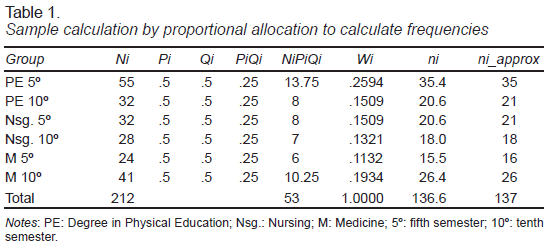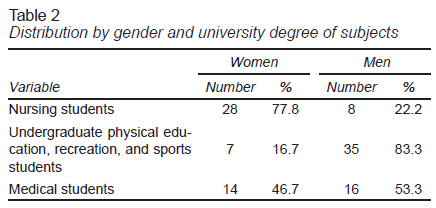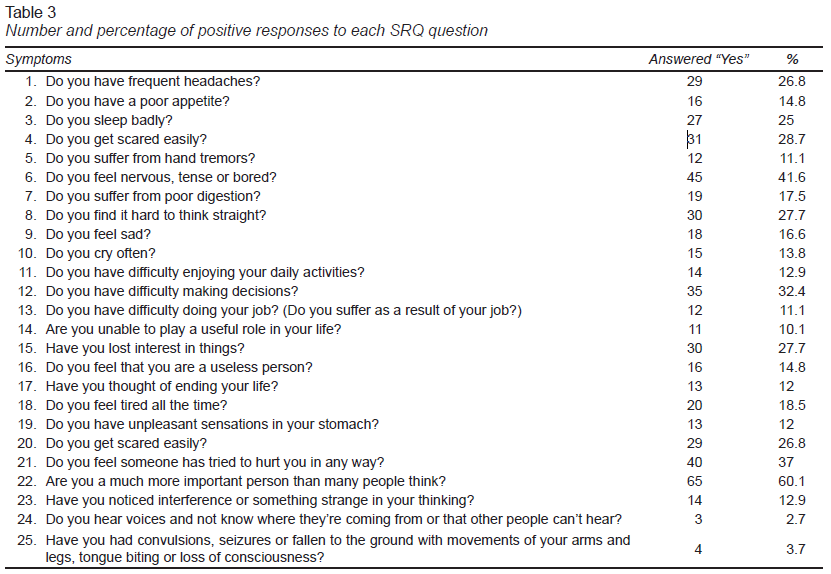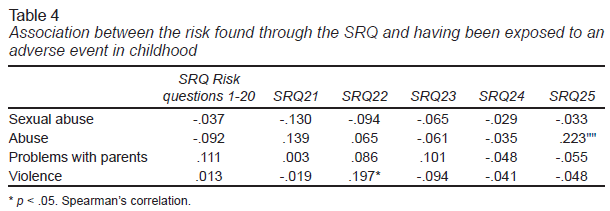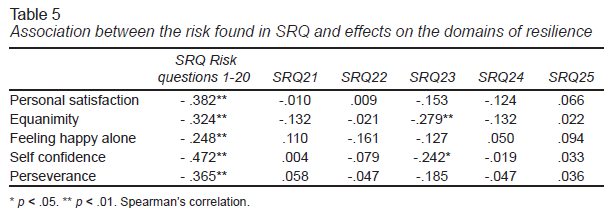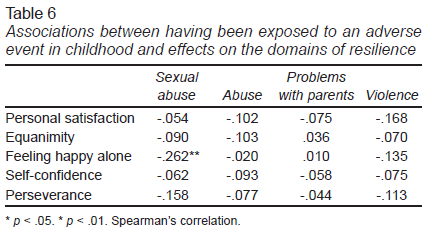INTRODUCTION
Up to 30% of young adults have reported a diagnosable mental illness, with 9% of these cases being considered severe (MacPhee et al., 2021). This rate increases in college students, among which there is a reported prevalence of 15% (Eisenberg, Hunt, & Speer, 2013), especially in those with personal, familial, and social stressors (Gong, 2020), and freshmen (Antúnez & Vinet, 2013). It has been observed that one in three students report mental health problems after being admitted to university (Bruffaerts et al., 2018). These alterations affect academic performance and contribute to university dropout (Lipson, Abelson, Ceglarek, Phillips, & Eisenberg, 2019).
Health-related university studies have a greater impact on mental health, as they are linked to a heavier academic load, exposure to stressors, relationships with peers frequently associated with competition, an imbalance between academic and personal life, academic problems, and proximity to suffering and death (Kunzler et al., 2020). Significant indicators of exhaustion, stress, and depression have been found in students in the area of health (Hill, Goicochea, & Merlo., 2018; Pacheco et al., 2017), which also have an impact on university dropout rates (Vega, 2021). This is not only evident among university students, since studies of health workers have reported a risk of developing depression and anxiety of 23.1% and 15.2%, respectively, following the onset of the pandemic (Mascayano et al., 2022).
The coronavirus pandemic brought many abrupt changes, such as the initial lockdown, the closure of educational establishments, working and learning from home, which decreased contact with colleagues and peers, loneliness, family conflicts, and proximity to the disease (Secord & McGrath, 2021). This impacted the lives of everyone, contributing to the already low probability of timely attention and exacerbating pre-existing disorders (Gunnell et al., 2020). According to UNICEF data from 2021, higher levels of anxiety and depression were reported in adolescents and young adults following the onset of the pandemic, coupled with decreased motivation and optimism about the future (UNICEF, 2021).
In the context of university students, there is also evidence of higher levels of depression, anxiety, stress, and changes in quality of life due to having to cope with this new reality (Husky, Kovess-Masfety, & Swendsen, 2020; Kaparounaki et al., 2020; Odriozola-González, Planchuelo-Gómez, Irurtia, & de Luis-García, 2020). In regard to mental health, there are both risk factors, such as adverse events in childhood (Vega-Arce & Nuñez-Ulloa, 2017) and substance use, and protective factors, such as support networks and healthy environments (Patel et al., 2018).
Resilience, understood as a personality trait that mitigates the negative effect of stress and encourages adaptation (Crombie, López, Mesa, & Samper, 2015), is the ability to prevail, grow, be strong, and even succeed despite adversity (Nunja Arroyo, 2016). Studies conducted on university students show acceptable levels of resilience, finding high and medium levels in students in the area of health (Flores, Estévez, & Machado, 2018; Villalba & Martínez, 2019), in addition to emphasizing it as a strong protective factor for mental health (Lavoie, Pereira, & Talwar, 2016), specifically in the university environment (Caldera Montes, Aceves Lupercio, & Reynoso González, 2016; Perales et al., 2019; Villalobos-Otayza, Vela-Alfaro, Wiegering-Gianoli, & Robles-Alfaro, 2019).
Within the framework of the COVID-19 pandemic, resilience has been shown to play a protective role with regard to mental health disorders (PeConga et al., 2020; Yildirim & Solmaz, 2022). Regarding its levels, studies have shown that they can remain stable (Castagnola Sánchez, Cotrina-Aliaga, & Aguinaga-Villegas, 2021), increase (Hernández-Ballester, Ferrer-Pérez, Montagud-Romero, & Blanco-Gandía, 2023), or be affected by alterations related to COVID-19 (Delgado, 2020; Killgore, Taylor, Cloonan, & Dailey, 2020).
Given the high impact of mental health alterations and their significant prevalence in university students, universities are an ideal setting for the early detection of potential alterations, as well as risk and protection factors (Lipson et al., 2019). Although several research projects have identified the link between adverse events and resilience and the mental health of university students, very few studies have explored this association within a socio-health crisis or individual responses to the transition to university life (Padrão et al., 2021). Having a baseline of risk factors, protective factors, and mental health factors and the association between these factors in university health science students will also make it possible to determine other mediating variables, particularly those linked to the university setting (Restrepo, Sánchez, & Castañeda, 2020). The aim of this study is to describe psychiatric symptoms and their association with adverse events in childhood and resilience in first-year students in the three undergraduate programs of the Health Sciences Faculty of the University of Caldas, Colombia in 2021.
METHOD
Design of the study
This is a descriptive, correlational, cross-sectional study comprising students enrolled in the nursing, physical education, recreation and sports and medicine programs of the Faculty of Health Sciences of the University of Caldas in the city of Manizales, Colombia.
Subjects/sample description
Students in the undergraduate programs of the Faculty of Health Sciences of the University of Caldas in the first semester of 2021. Maximum variance was used (expected prevalence of 50%) for the estimate, given that the results of previous studies indicate a prevalence of 47% to 56% for mental health problems (Gómez-Restrepo, 2016) as shown in Table 1.
As a result of a decision by the researchers, a selection probability equal to 1.0 was assigned to all students enrolled in the first semester of 2021 in the three programs with a view to this group becoming a cohort for subsequent studies. A total of one hundred and ninety students in the first semester of 2021 were included, in keeping with historical data. The sample size calculated for the study comprised sixty people in each bachelor’s degree program (physical education, recreation and sports, nursing, and medicine), making a total of 180.
Measurements and procedure
A virtual self-completion survey was administered through the institutional mail of each student once authorization had been obtained through the informed consent form included. Three instruments were used to measure the variables of interest.
The Self-Reporting Questionnaire (SRQ) designed by the World Health Organization (Beusenberg, Orley, & World Health Organization, 1994) and used by the National Mental Health Survey of Colombia (Gómez-Restrepo, 2016) was administered to detect affective symptoms. It consists of two parts, the first comprising twenty questions related to symptoms of depression, anxiety or both, with subjects testing positive with a score equal to or greater than eleven points. The second part consists of five questions for the detection of symptoms related to psychosis and seizures. In this part, each question scores as individual risk. In validation studies in Latin America, including Colombia, a sensitivity of 62.9% to 90% and a specificity of 44% to 95.2% were determined, together with an internal consistency of .81 (Cronbach’s alpha; Beusenberg et al., 1994).
For resilience, Wagnild and Young’s Scale was used, comprising twenty-five items scored on a seven-level Likert-type scale, in which one means disagreement, and seven total agreement. The scale has five components: self-confidence, equanimity, perseverance, personal satisfaction, and feeling happy alone, the minimum score being twenty-five and the maximum 175 (Wagnild & Young, 1993). In adaptations for adolescent populations, the instrument has shown a reliability level of .90 and adequate levels of adjustment (Bravo-Andrade et al., 2019). In the Colombian university population, the instrument was adapted with a reliability of .846 (Oviedo-Feria, 2017), which was used in the present study because it showed adequate psychometric properties in a population similar to the one studied.
Four questions were included: “Were you a victim of any type of sexual abuse in your childhood?” “Were you a victim of abuse in childhood?” “Did your parents divorce or did one of them die or abandon your home during your childhood?” “Were you a victim of violence in the community or social context during your childhood?” with response options “Yes,” “No,” and “Do not remember” to identify adverse events in childhood.
Statistical analysis
Categorical variables are described using frequency distribution tables. The associations between the risk found through the SRQ and having been exposed to an adverse event in childhood, the risk found through the SRQ and alteration of the domains of resilience and having been exposed to an adverse event in childhood and alteration of the domains of resilience was determined through Spearman’s correlation coefficient. SPSS version 26.0 software was used.
Ethical considerations
This study meets the standards for research in human beings as provided for in resolution No. 008430,1993 of the Ministry of Health and in the Declaration of Helsinki 2000. It is a minimal risk investigation. This project was approved by the Maternal and Child Department and the medical ethics committee of the Faculty of Health Sciences of the University of Caldas, through act CB022 2020.
The necessary measures were taken at all times to respect the privacy of the subjects by encoding the information when it was systematized. Each of the subjects was offered clear, accurate information on the purpose and objective of the study and the meaning of their participation, which was corroborated by signing an informed consent form. Subjects were informed that the information collected in this research project would be confidential. The published results would preserve their accuracy, and reference global rather than individual data.
Whenever a risky alteration was detected, a care route was activated by contacting the university health services and the health services of each person. In addition, a meeting was held with at-risk people to provide them with psychoeducation and show them health care routes. This was done while respecting the privacy and confidentiality of each person in individual spaces. At the same time, identification data were stored in a database to which only the principal clinical investigators had access and was revealed when the health routes were mentioned, with the authorization of each student.
RESULTS
Of the 180 students enrolled in the first semester of the programs included, 108 agreed to participate. The mean age was 19.6 years. Table 2 contains the distribution by gender and university degree program of the subjects.
After the administration of the SRQ (Table 3), it was found that seven students (6.4%) had eleven or more positive responses. Four of them were enrolled in the nursing (57.1%), two in the physical education, recreation, and sports (28.5%), and one in the medical degree program (14.2%). The most frequent symptom was “feeling nervous, tense or bored” with 47.2% of the students reporting the presence of at least four symptoms that suggested depression or anxiety and 12% answering “yes” to the question “Have you ever thought of ending your life? In the second part of the instrument, it was found that 75% of students had given at least one positive response.
Wagnild and Young’s scale was used to measure resilience, finding that the minimum score was seventy-two, corresponding to a nursing student and that the maximum was 172 for a medical student, the average being 142.1. To determine the levels of resilience, the percentiles of the data were taken as follows: low scores were less than 125 (p 25), medium scores were between 125 and 156 (p 25-75), and high scores were greater than 156 (p 75). Students in this study were mostly observed to be in the medium level (52.7%), followed by the low level (25%), and lastly the high level (22.2%).
The most commonly reported adverse event in childhood was “abuse” (42.5%), particularly in students with a degree in physical education, recreation, and sports, followed by “parents who divorced, or one of them died or left home” (7.4%), and “violence in the community or social context” (4.6%). The least frequently reported adverse event was “sexual abuse” (1.8%).
In addition, a statistically significant association was found between having been exposed to adverse events in childhood and having answered “yes” to two questions in the SRQ, which were “Have you had seizures, attacks or fallen to the ground with movements of your arms and legs, tongue biting or loss of consciousness? (p = .020) and “Are you a much more important person than many people think?” (p = .041), as shown in Table 4.
A statistically significant association was also found between the presence of symptoms that compromise mental health and affect all domains of resilience, as can be seen in Table 5.
Likewise, Table 6 shows the statistically significant association found between having been exposed to sexual abuse in childhood and effects on the “feeling happy alone” domain of resilience (p = .006). No significant association was found between having been exposed to other adverse events and effects on the domains of resilience.
DISCUSSION AND CONCLUSION
There is a high prevalence of mental health disorders among university students (Pacheco et al., 2017), which has been compounded by the advent of the COVID-19 pandemic, particularly in workers and students in the area of health (Vélez-Botero et al., 2023) and in low- and middle-income countries, exacerbating existing inequities (Arora et al., 2022; Kola et al., 2021). In the present study, psychiatric symptoms and their association with childhood adverse events and resilience in health sciences students were described, which points to the need to address these issues.
When people are exposed to adverse situations that demand a response from the individual, a series of strategies are set in motion to deal with them. This underlines the fact that both adverse events in childhood and resilience influence this response. The association between adverse events in childhood, resilience, and mental health has been demonstrated in previous studies, such as the meta-analysis by Yule, Houston, and Grych (2019), which notes that while exposure to adverse experiences can increase the risk of psychopathology, there are also protective factors such as family, school, and peer support that promote resilience and adaptive behaviors. The relationship between these three factors has been observed even if there are existing mental pathologies (Liu et al., 2020).
Compared with those enrolled in other degree programs, health sciences students are at a higher risk of mental problems or disorders and experience a greater impact on resilience associated with stressful events (Leitón Espinoza et al., 2022). Apart from factors related to their development, this is associated with having a heavy academic load, long hours of study and a large volume of information, as well as exposure to stress, a competitive relationship with peers, fear of failure, finding a balance between study and leisure, alterations of family and couple relationships, fear of the future, financial problems, living apart from their families, and physical exhaustion (Kunzler et al., 2020).
In regard to the risk of presenting an anxiety disorder or depression or both, the present study found that 6.4% of students tested positive for these in the instrument used (SRQ), which was lower than the rate observed in the 2015 National Mental Health Survey (ENSM) conducted in Colombia (11.2% for adolescents and 9.6% for young adults) (Gómez-Restrepo, 2016). The same instrument was used in a meta-analysis by Pacheco et al. (2017) that included medical students, in which 31.5% of subjects tested positive. In the study by Gomes, Pereira Junior, Cardoso, and Silva (2020), 39.9% of respondents tested positive with this instrument. It should be noted that subjects included students drawn from various degree programs and enrolled in different semesters. However, specifically in nursing and medicine, 43.8% and 27.3% respectively were classified as having a possible risk of presenting mental health disorders.
After the administration of the SRQ, it was found that the most frequently reported symptoms resembled those found in the ENSM for similar age groups. In the present study, “feeling nervous, tense or bored” was the main symptom in the first part and “being a much more important person than many people think” the main one in the second. It is worth noting that 12% (compared to 6.2% and 6.8% reported in the ENSM) answered “yes” to the question “Have you ever thought of ending your life?” In addition, without regarding them as having tested positive for anxiety or depression, with the aforementioned cut-off point, 47.2% of the students reported the presence of four or more symptoms in the first part of the instrument, which was similar to the results of the ENSM (50.5% and 53.1%; Gómez-Restrepo, 2016), which points to symptoms that require identification and monitoring in university students.
The present study revealed exposure to adverse events in childhood in university students, as described in the study by Karatekin (2018), who noted that 30% of university students reported exposure to two adverse experiences in childhood while an additional 22% had been exposed to at least one. At the same time, other studies also report events related to problems with parents according to Cheng, Zhao, Wang, and Sun (2020) or sexual abuse, as noted by Soldatou, Pantzios, Panagiotou, Panagiotopoulos, Nicoletos, and Michala (2021).
The negative impact of adverse events in childhood on mental health has been demonstrated in previous studies (Gardner, Thomas, & Erskine., 2019; Piñeros-Ortiz et al., 2021; Pirdehghan, Vakili, Rajabzadeh, Puyandehpour, & Aghakoochak, 2016; Sánchez Acosta et al., 2019). This was also observed in the results of the present study, since a statistically significant association was found between having been exposed to abuse or violence in childhood and answering “yes” to questions identified in the SRQ on individual risk, namely “Have you had convulsions or seizures or fallen to the ground with movements of your arms and legs and tongue biting or lost consciousness?” (p = .020) and “Are you a much more important person than many people think?” However, it is worth noting that there was no association with all the individual risk questions, or with risk in the first twenty questions of the SRQ, which supports the view that not everyone exposed to adverse events will necessarily experience alterations to their mental health, since protective factors such as social support and resilience play a key role (Su, D’Arcy, & Meng, 2020).
This association may be linked to the lockdown dynamics of the pandemic, in which students may have lived in adverse family environments (Valdivieso, Burbano, & Burbano, 2020). It is also typical of problems experienced by university students due to the pandemic, particularly those involving social isolation, financial problems, access to technologies, fear of infection, and socialization with peers (United Nations Educational, Scientific and Cultural Organization, 2020).
Regarding the effect of these adverse factors in childhood on resilience, in the present study, a statistically significant association was found between having been exposed to sexual abuse in childhood and having one of the domains of resilience compromised, namely “feeling happy alone”. However, no significant association was demonstrated between having been exposed to the other adverse events and effects on other domains of resilience. This has been described in previous studies such as the one by Lavoie et al. (2016), which states that protective factors can contribute to a positive environment for emotional growth and progress, even though people have had to experience previous situations of stress or adversity. Likewise, studies such as those by Henao Rojas, Ponce García, Zuluaga Gil, Posada Gómez, and Zapata Zabala (2020) observe that resilience levels can be maintained despite the stress experienced.
After the administration of Wagnild and Young’s Resilience Scale, the present study found an average of 142.1, which is similar to that of other publications using the same instrument, albeit with different age ranges and including other university degrees programs, not only those in the area of health. Similar results were reported by Rodríguez (2021), where the average was 138.7, and Caldera-Montes et al. (2016) in Mexico, where the average was 144.6. A Portuguese study reported a mean of 129.4, which is lower than the results found in the aforementioned studies (Gonçalves & Camarneiro, 2018).
This is how both high (Ordoñez Morales, 2020) and medium (Mejía, 2018) levels of resilience have been reported in university students despite adversity such as the pandemic. During this time, they continued to be reported as moderate (Medina, Lujano, Aza, & Sucari, 2020), and constituted an effective tool for continuing to cope with difficulties and mitigating the possible negative impacts on mental health.
As for the association with mental health problems, as previously described in reviews, subjects with low resilience are more likely to develop mental health problems (Gower et al., 2020; Villalobos-Otayza et al., 2019; Perales et al., 2019). The present study found a statistically significant association between having experienced some form of risk identified in either of the two blocks of the SRQ (questions one to twenty and twenty-one to twenty-five) and effects on the domains of resilience.
Apart from this review undertaken by Cochrane (Kunzler et al., 2020), other studies also indicate that these factors may impact the strengthening of resilience and post-traumatic growth (Chi et al., 2020; Hernández-Ballester et al., 2023) in students in the area of health. These factors could be explored in longitudinal studies once the health emergency has ended.
Limitations of the present study include the impossibility of undertaking a longitudinal analysis, which could indicate how the factors determined in the study influence the recovery processes after a traumatic event, and identify other sociodemographic factors in the response to socio-health crises. One of the strengths of the study is that it pinpoints aspects of future health professionals within the framework of a global emergency that could be considered in possible interventions in university life, such as adverse childhood events, resilience factors and mental health in general.
The COVID-19 pandemic has had a major impact on mental health, increasing the effects associated with the latter, which is why it is essential to promote mental health, particularly in future health workers, including all areas of performance and levels of complexity, since they are regarded as being extremely vulnerable to the effects of this situation. Lastly, the data obtained in the present study are considered valuable, since it is essential to promote protective factors such as resilience, and provide timely care for the possible consequences of adverse events in childhood in young university students that could interact with specific factors of the educational environment and this stage of life during their time at university.
